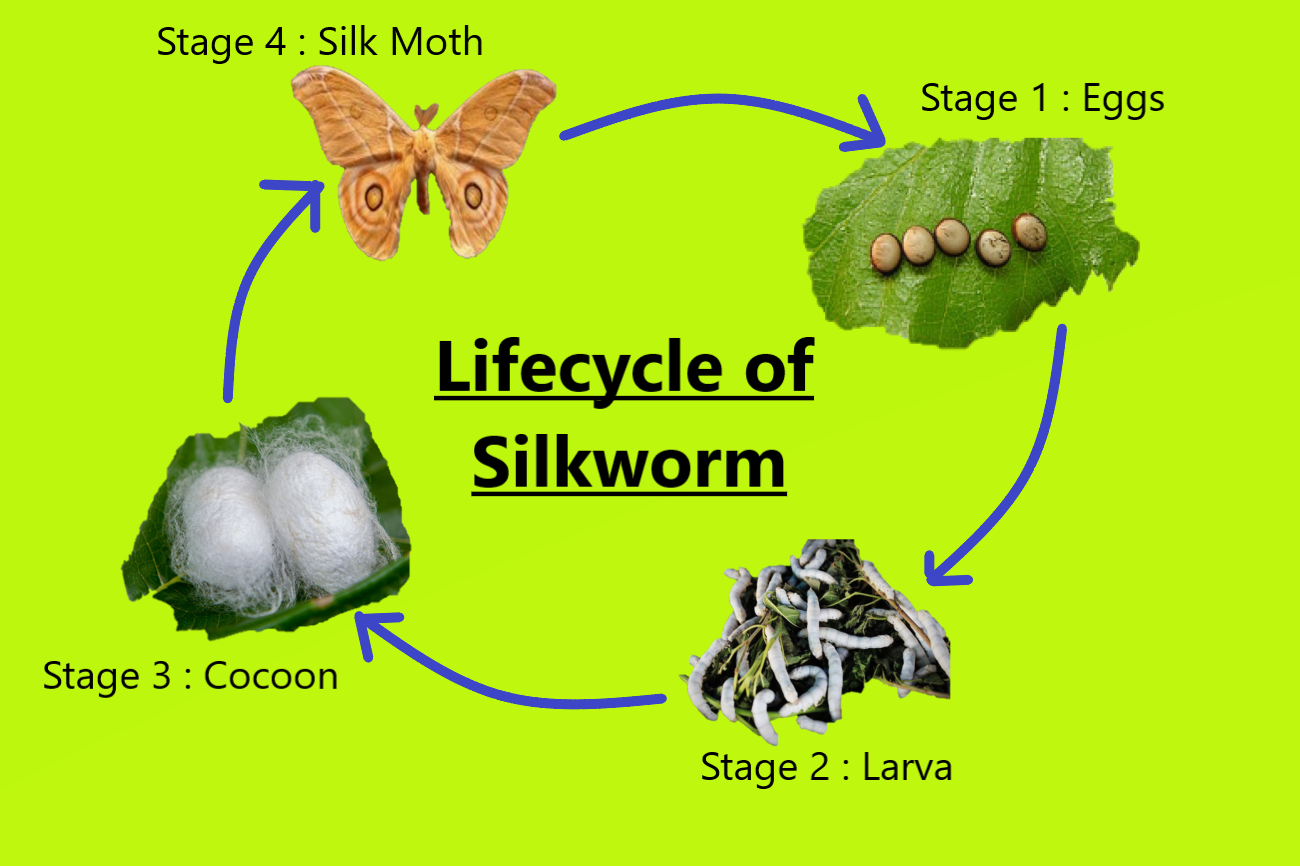
The rearing of silkworm for the production of silk is known as
(a) Horticulture
(b) Sericulture
(c) Apiculture
(d) Pisciculture
Answer
493.2k+ views
Hint: Rearing of animals means animals raised or bred for their use, for pleasure or profit, often for food. The produced goods are used for commercial purposes. Silk is the finest and costly material used in the clothing industry.
Complete answer:
Rearing of the silkworm is done to produce raw silk. It is known as sericulture. Silkworms are reared at appropriate temperature and humidity to urge silk threads from cocoons in sericulture. In the process, firstly female silk moths lay hundreds of eggs that are stored over a clean paper or piece of cloth and sold to the silk farmers.
Additional Information: -At appropriate temperature and humidity, the egg hatches to produce larvae or caterpillars. This process is done when the mulberry trees have a fresh crop of leaves. The caterpillar continuously eats the mulberry leaves and its size increases.
-After 30-40 days approximately the caterpillars stop eating the leaves and then it begins to spin cocoons. The cocoons are produced by the secretion of the liquid protein from their salivary glands.
-Silk moths are developed inside the cocoons. These cocoons are used to obtain silk threads.
-When the cocoons are exposed to the sun or steam or boiled, the silk fiber gets separated. The feeling of the silk is carried out by special machines.
-Silk fibers are then converted into silk threads to form different sorts of silk fabrics like silk sarees, etc. by the weavers.
So, the correct answer is,’ sericulture’.
Note: -Many thousands of years ago, the process of making silk was invented by the Chinese.
-A silkworm takes at least two days to complete its cocoon.
-Silk is a naturally occurring insulator. It remains cool in the summer and warm in the winter.
-A single, unbroken thread measures about 914 meters long, making one silkworm cocoon.

Complete answer:
Rearing of the silkworm is done to produce raw silk. It is known as sericulture. Silkworms are reared at appropriate temperature and humidity to urge silk threads from cocoons in sericulture. In the process, firstly female silk moths lay hundreds of eggs that are stored over a clean paper or piece of cloth and sold to the silk farmers.
Additional Information: -At appropriate temperature and humidity, the egg hatches to produce larvae or caterpillars. This process is done when the mulberry trees have a fresh crop of leaves. The caterpillar continuously eats the mulberry leaves and its size increases.
-After 30-40 days approximately the caterpillars stop eating the leaves and then it begins to spin cocoons. The cocoons are produced by the secretion of the liquid protein from their salivary glands.
-Silk moths are developed inside the cocoons. These cocoons are used to obtain silk threads.
-When the cocoons are exposed to the sun or steam or boiled, the silk fiber gets separated. The feeling of the silk is carried out by special machines.
-Silk fibers are then converted into silk threads to form different sorts of silk fabrics like silk sarees, etc. by the weavers.
So, the correct answer is,’ sericulture’.
Note: -Many thousands of years ago, the process of making silk was invented by the Chinese.
-A silkworm takes at least two days to complete its cocoon.
-Silk is a naturally occurring insulator. It remains cool in the summer and warm in the winter.
-A single, unbroken thread measures about 914 meters long, making one silkworm cocoon.

Recently Updated Pages
Master Class 12 Business Studies: Engaging Questions & Answers for Success

Master Class 12 English: Engaging Questions & Answers for Success

Master Class 12 Social Science: Engaging Questions & Answers for Success

Master Class 12 Chemistry: Engaging Questions & Answers for Success

Class 12 Question and Answer - Your Ultimate Solutions Guide

Master Class 12 Economics: Engaging Questions & Answers for Success

Trending doubts
The gas that burns in oxygen with a green flame is class 12 chemistry CBSE

Most of the Sinhalaspeaking people in Sri Lanka are class 12 social science CBSE

Give 10 examples of unisexual and bisexual flowers

Draw a labelled sketch of the human eye class 12 physics CBSE

Differentiate between homogeneous and heterogeneous class 12 chemistry CBSE

Write a short note on Franklands reaction class 12 chemistry CBSE




